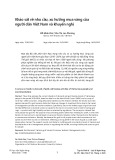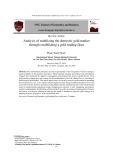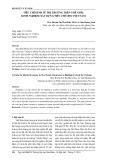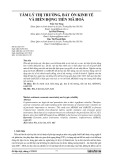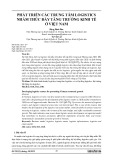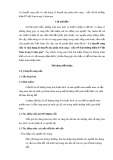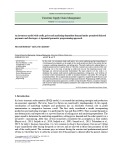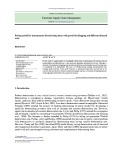
* Corresponding author
E-mail address: drahmednahar@gmail.com (A. N. Al-Hussainia)
© 2019 by the authors; licensee Growing Science, Canada
doi: 10.5267/j.uscm.2018.12.002
Uncertain Supply Chain Management 7 (2019) 457–470
Contents lists available at GrowingScience
Uncertain Supply Chain Management
homepage: www.GrowingScience.com/uscm
A study on sales growth and market value through supply chain
Ahmed Nahar Al-Hussainia*
aThe Public Authority for Applied Education & Training, The College of Business Studies, State of Kuwait
C H R O N I C L E A B S T R A C T
Article history:
Received November 5, 2018
Accepted December 4 2018
Available online
December 4 2018
This paper examines the effect of supply chain on performance indicators including sales growth
and market value in the context of manufacturing firms in Kuwait. The dimensions of supply
chain; namely strategic supplier partnership, information sharing, and information quality are
also added in the model. Along with sales growth and market value, industry leadership, future
outlook, overall response to competition, overall business performance, employee’s productivity,
process productivity, and success rate in the launching of new product are some of the important
indicators for measuring firms’ performance. Both factor analysis and structural equation
modelling approaches are applied to the sample of 314 respondents taken from the manufacturing
firms in Kuwait. Factor analysis provides some evidence that all the indicators for supply chain
and business performance can be considered for the structural modelling and regression analysis.
The core findings under structural modelling indicate that both strategic supplier partnership and
information sharing had positive and significant impacts on the overall business performance.
However, information quality appears to be the insignificant determinant of business
performance. For the sales growth and market value, strategic supplier partnership and
information sharing are significant determinants obtained through the regression analysis. The
originality of the study can be viewed with reference to the selected performance measures and
their determination through supply chain management. However, this study is confined only to
the manufacturing sector and the services sector can be focused by incorporating additional
performance measures and suitable sample size in future studies.
daensee Growing Science, Cana
b
y the authors; lic9© 201
Keywords:
Business performance
Supply chain
Sales growth
Market value
Kuwait
1. Introduction
For economic and financial growth, the manufacturing sector is considered to be the key role player.
In order to assess economic development, the impact of this sector has been recorded both in domestic
and international environment (Turner, 1988). With industrialization, developed countries around the
globe are heavily dependent on financial development with the strategic objectives and progress (Reed,
2002). Subject to a firm, the idea of performance is not only a significant gauge to understand the
present situation of the business, but it also helps to predict the future position of the business. The
indication of financial health of business covers the role of leadership while keeping the business on
track (Bryson, 2018; Nguyen, 2017). For better business performance, significant attention is required
on both financial and non-financial resources.

458
Performance measurement of the business is very much critical for the academic writers and managers
in the firms. In its general context, the idea of firm performance (FP) is referred to the operational
capability of the business or a company to satisfy its key shareholders in the marketplace (Smith &
Reece, 1999). Meanwhile, it expresses the organizational achievements either in long run or in the short
run. In literature, the context of strategy and its association with the business performance has been
examined for many years. Besides, scholars and researchers have clearly examined the importance of
performance in business organizations (Brinckmann et al., 2010; Hughes & Morgan, 2007). Many
researchers consider the FP with the context of small and medium enterprises (SMEs) (Alasadi &
Abdelrahim, 2008; Collis & Jarvis, 2002; Jarvis et al., 2000; Keil et al., 2008). It is also expressed that
business performance measurement system (PBMS) is an important indicator in the field of
management sciences. This system reflects the various factors which are impacting the performance of
the business through quality indicators. The concept of supply chain management is considered as an
important concept among the significant determinants of business performance in contemporary
literature (Giunipero et al., 2008; Maurice, 2013; Purnama, 2014; Chielotam, 2015; Mowlaei, 2017;
Albasu & Nyameh, 2017; Maroofi et al., 2017; Kucukkocaoglu & Bozkurt, 2018; Maldonado-Guzman
et al., 2018). Numerous studies have implemented SCM in firms, which deals in retail business as well
as in manufacturing (Li et al., 2006). Sandberg and Abrahamsson (2010) analyzed that SCM is
impacting the performance of business firms, but still a significant gap is available to cope with business
performance. Based on this idea, the present study aims to focus on the concept of SCM as a key
determinant of business performance from the context of manufacturing firms, working in Kuwait. The
manufacturing sector in Kuwait, deals with the petrochemicals, ammonia and fertilizers. Meanwhile,
the contribution of the manufacturing sector towards the growth domestic product (GDP) has been from
5 to 6 percent over the last couple of years and the target of the government is to increase its contribution
in GDP by more than its contribution witnessed in previous years. Different initiatives have been taken
in recent years to promote the manufacturing sector in Kuwait, like the Kuwait Development Plan
(KDP) having a worth of US$102 billion. In addition, government has announced an increased budget
of US$1.7 billion for the manufacturing sector. Fig. 1 indicates value added of the manufacturing sector.
Value added (% of GDP) for Kuwait over recent years i.e. from 2010 to 2016, the figure indicates an
increasing trend from 5.61 percent in 2011 to 7.27 percent of GDP in 2016.
Fig. 1. Manufacturing sector value added % of GDP in Kuwait Source: WDI (2018)
The rest of the paper is as follows. Section two deals with the review of the literature with context to
business performance and supply chain. Section three describes the variables and their operational
consideration. Section 4 indicates the sample and methodology being adopted in the analysis. Section
5 provides a detailed discussion about results and findings. Last section deals with the conclusion and
future implications of the study.
2010
14%
2011
13%
2012
14%
2013
13%
2014
13%
2015
16%
2016
17%

A. N. Al-Hussainia / Uncertain Supply Chain Management 7 (2019)
459
2. Literature Review
Business organizations work for the competitive advantage in the market, which enables them towards
better financial performance (Lado et al., 1992). Due to its significance in the present literature, supply
chain (SC) seems to be the important factor for the business organization in achieving sustainable edge
over its rivals (Ploos van Amstel & Starreveld, 1993). However, SC has shifted its role from shaping
the structure of cost control to stability in its earnings. To deal with the customer satisfaction, businesses
are involved with the core processes based on the supply chain. It can be expressed that the success of
the business organization significantly depends on the SC process and activities. The review of the
literature explains that little empirical evidence can be found regarding company’s performance and its
integration. The relationship between SC and business performance has been examined from the
context of transaction cost theory. While some studies have investigated this relationship under
organizational capability related to the resource-based view (RBV) (Wernerfelt, 1984). The
assumption of RBV indicates that through organizational resources and capabilities, business firms
achieve the competitive advantage in the market (Peng et al., 2008; Anigbogu & Nduka, 2014; Santhi
& Gurunathan, 2014; Anyanwu et al., 2016; Jones & Mwakipsile, 2017; Mosbah et al., 2017;
Malarvizhi et al., 2018, Le et al., 2018). So, the indication of the SC can be viewed as both internal
and external integrated capabilities that can directly impact the performance of the business firms.
Besides, most studies have been conducted on the business performance of the firms in US, while
ignoring the other cultures and business trends in various regions. For instance, China is considered to
be a manufacturing hub for the global economy and plays an integral role in global supply chain and
business performance (Hu & Mao, 2002). The study conducted by Flynn et al. (2010) expresses the
fact that manufacturers in China are creating significant value for both theoretical and empirical
literature.
Prior studies on business and organizational performance have suggested a range of options to analyze
the company’s performance. For instance, according to Chen et al. (2004), Mahmood et al. (2016) and
Javad and Basheer (2017) for overall attainment of strategic objectives, the performance of the firm
should be the prime focus, as it is a necessary and a primary goal to make earnings for the shareholders.
Various performance theories have considered the idea of financial outcomes to discuss organizational
success (Boyer, 1999). However, some other academic researchers discussed the limitations of
financial performance and its integration with the supply chain. For instance, according to Beamon
and Balcik (2008) numerical performance of the business usually fails to define the system performance
in a proper way and reaches a vague indicator for the qualitative evaluation. Many other researchers
have cleared the idea that for the business performance, broader conceptualization is very much
essential for both the operational and financial outcomes (Kaplan & Norton, 2001, 2007; Vickery et
al., 2003). In another study conducted by Tracey et al. (2005), along with financial performance they
incorporated three broader measures of performance i.e. organizational capacity OC, supplier-oriented
performance SOP, and customer-oriented performance COP. All these set of indicators collectively
reflect the business performance. The concept of OC can be expressed as the business ability of a firm
to perform in a productive way and link the business activities with the capacity of its operations
through effective and significant transformation of input into output (Babakus et al., 1996). It is also
known as the organizational intended performance or operational strength in the field of operation
management. In the study of by Kusunoki et al. (1998), major categories of OC have been defined
under the title of global, upper-level management, product or services, the information system of the
business, and the relationship capabilities of the business. While taking resource based assumptions,
almost 32 capabilities can be considered under OC (Lavie, 2006). Some other studies consider OC as
dynamic capabilities which are referred to the structure, both internal and external competencies that
deal with the competitive advantages of the business (Schreyögg & Kliesch‐Eberl, 2007; Wade &
Hulland, 2004). In addition, some literature findings on business and organizational performance,
suggest a range of factors for measuring business performance. For instance, Saeidi et al. (2015)
indicate that financial performance is a key focus of the overall business performance and is widely
available in the existing body of the literature.

460
In recent time, the supply chain has got significant attention as it is known as an integrated, systematic
and strategic coordination of business functions. It covers the flow of materials, processes, and
information across the business firms as well as units from supplier to the manufacturer for the
improved business performance in the long-run (Ballou, 2007; Basheer et al., 2018). The idea of supply
chain integration (SCI) is expressed in numerous studies as a degree to which a firm can strategically
collaborate with the SC patterns and cooperatively manage the inter-organizational processes
(Braunscheidel & Suresh, 2009). Some authors explain that success of the company and supply chain
activities are closely associated with each other (Fabbe-Costes et al., 2008). The view of Ahi and Searcy
(2013) focused on the effect of SCM on financial performance, as various challenges exist for the
measurement of supply chain practices in the field of business. Earlier studies have focused on the
buyer-supplier association while reducing the role of supplier, developing a long-run relationship and
continuous communication (Chen & Paulraj, 2004). There is a considerable attention for the SC and
firms’ performance. For SC, the factors like strategic supplier partnership, information sharing,
information quality, and customer relationship have been discussed in some studies. While some other
studies have considered the factors of postponement, risk and reward sharing along with agreed vision
and goals of the business and strategic supplier (Sundram et al., 2011). Meanwhile, factors in supply
chain practices like management of customer and supplier, communication among the parties, quality
and service indicators, and lean retailing practices are also observed for the organizational performance.
Therefore, the focus of the present study is to investigate the effect of supply chain activities on sales
growth, market value and other business performance measures.
3. Variables and Methods
The focus of the present study is to examine the impact of supply chain management on the business
performance of manufacturing firms in Kuwait. The following variables are considered to measure the
factors of SCM and business performance.The strategic relationship with the key supplier in the
business firm has been studied for many years. In this regard, the selection of suppliers and business
integration with such parties is known to be a significant decision for the business under supply chain
management. Various studies have found that strategic sourcing can improve the performance of the
supply chain. In the manufacturing sector, strategic sourcing is closely associated with the performance
(Narasimhan & Jayaram, 1998). They also expressed that strategic sourcing covers outsourcing and
capability analysis of the supplier. To examine this association, a second order construct is developed
for 215 manufacturing firms working in North America. Besides, the idea of strategic sourcing is also
found to be significantly important determinant in defining the concept of knowledge creation and its
sharing with the suppliers and retailers (Dewsnap & Hart, 2004). As both the parties of suppliers and
retailers are linked for the sharing of diverse knowledge, their combination can lead to the improved
and unique category of knowledge for the better business performance. To measure the idea of strategic
supplier partnership, four items have been added in the model as helping supplier for the improvement
of quality, continuous improvement programs including suppliers, supplier partnership in planning and
goal setting, and involvement of the supplier in new product development process (Hamister, 2012).
Information sharing refers to the sharing of non-public information with the supply chain by various
parties. Several studies have empirically examined the role of information sharing in supply chain and
got significant findings based on the stimulation approach. On the other hand, sharing of information
between the manufacturer and other parties in the overall supply chain process can be very much useful
(Iyer & Ye, 2000). Numerous promotional activities can increase the demand in a specific time and can
distort the activities of the supply chain. Because of this increased demand, lack of proper sharing of
information between supplier and the manufacturer will likely to interrupt the business performance.
Without the sharing of information, business performance cannot be achieved in an integrated way. In
a study by Hamister and Suresh (2008), it is observed that the value of information sharing is high when
the demand is autocorrelated with it. Moreover, it is observed that the scope of information sharing is
significantly associated with the nature of the business (Towers & Burnes, 2008). To analyze the factor
of information sharing, the present study considers four items i.e. sharing of proprietary information by

A. N. Al-Hussainia / Uncertain Supply Chain Management 7 (2019)
461
the supplier with the business, information from the supplier about key issues, exchange of information
between the supplier and the business, and business planning based on shared information by the
supplier. Information quality indicates the concept of true and accurate information sharing between
the supplier and the business firm. Accurate and timely sharing of relevant information is an important
indicator for performance enhancement in supply chain (Gavirneni et al., 1999). They stated that quality
of information is a meaningful tool during the process of inventory management under different levels
of capacity constraints. It was also found that distortion in information sharing can lead to the creation
of bullwhip effect in the supply chain and finally increases the cost of the business, which in turn lowers
the business performance (Lee et al., 1997). Under information quality, after careful understanding of
the literature, four items namely; timely, accurate, complete, and reliable dimensions are added in the
questionnaire.
The business performance is a multi-dimensional concept, covering a strong theoretical and empirical
foundation for its management. Numerous studies have covered different factors to express their view
regarding business performance. It has been studied under the areas of accounting, finance, marketing
operation management and other areas in business and economy. Industry leadership defines the
business performance of a leading organization through its higher sales growth, more earnings and
better market share compared with its rivals (Ferguson & Stokes, 2002). Future outlook of the company
is also a key indicator for measuring company’s performance (Faulkner & Schwartz, 2009; Feldstein,
2000). Whereas, overall response to the competition in the market, the success rate in the new product
and overall business performance are significant determinants for assessing the business performance.
The level of productivity of the process and employees (Quinn, 2018), sales growth (Brush et al., 2000),
profit growth (Morgan et al., 2009) and overall market value of the company (McConnell & Muscarella,
1985) are some other factors to express business performance. Analyses of the present study have
considered all these dimensions to express business performance in the manufacturing sector, while
more focus is paid to the factors of sales growth and current market value (Suryanto et al., 2018)
4. Sample and Methods of Analysis
To analyze the impact of supply chain management on business performance, individuals from various
manufacturing units linked to the supply chain and business processes were selected. A sample of 314
respondents was finalized for the empirical analysis of the study. To get the results, a structural model
was developed by incorporating the factors of supply chain and business performance. The path of the
analysis was based on the confirmatory factor analysis (CFA), structure equation modelling (SEM) and
finally the regression analysis for the impact of the supply chain on sales growth and current market
value of the manufacturing firms. In the very first step, overall factor analyses were performed. In the
2nd step, structural equation modelling technique was applied for an overall model of the study. While
seperate regression analyses, specifically for the sales growth and current market value was also taken.
The items of supply chain and business performance were measured on five points Likert scale, ranging
from strongly disagree to strongly agree, and from bottom to top, respectively.
5. Results and Discussions
Table 1 indicates the trends of the data set through a descriptive analysis of the study. To measure the
factors of supply chain management, four factors of strategic supplier partnership (SSP1-SSP4,
information quality (IQ1-IQ4), information sharing (IS1-IS4) and information intensity (INTS1-
INTS2) have been added to the model. To measure the business performance, various items like
industry leadership (INDL), future outlook (FOUTLK), overall response to competition (ORC), overall
business performance (OBP), employee’s productivity (EP), process productivity (PPRO), sales growth
(SG), profit growth (PG), company’s market value (CMV), and success rate in the launching of new
product (SRNP) have been added in the model. The overall observation for all the items is 314,
indicating that all the respondents have provided their meaningful responses. For strategic supplier
partnership, all four indicators have a mean score of above 4, which explains that respondents are
agreed upon all the four items of SSP i.e. helping the supplier to improve the quality of the product

